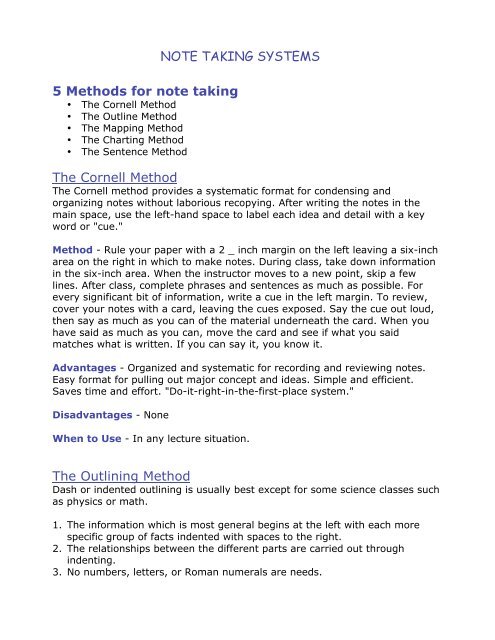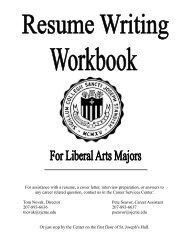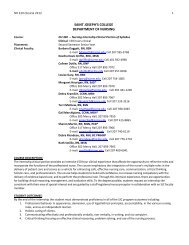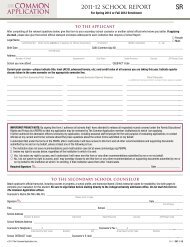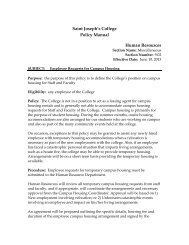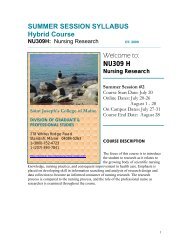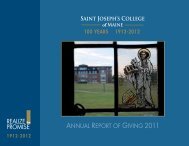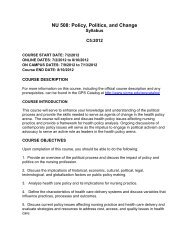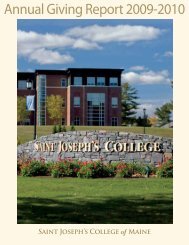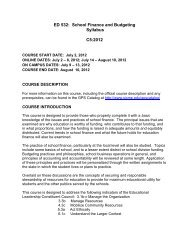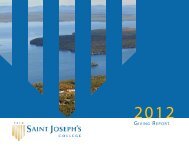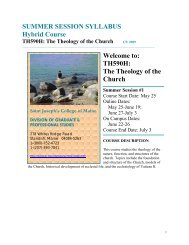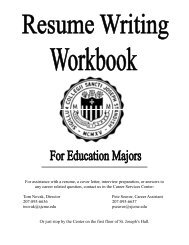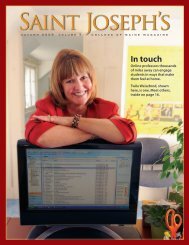NOTE TAKING SYSTEMS 5 Methods for note taking The Cornell ...
NOTE TAKING SYSTEMS 5 Methods for note taking The Cornell ...
NOTE TAKING SYSTEMS 5 Methods for note taking The Cornell ...
Create successful ePaper yourself
Turn your PDF publications into a flip-book with our unique Google optimized e-Paper software.
5 <strong>Methods</strong> <strong>for</strong> <strong>note</strong> <strong>taking</strong>• <strong>The</strong> <strong>Cornell</strong> Method• <strong>The</strong> Outline Method• <strong>The</strong> Mapping Method• <strong>The</strong> Charting Method• <strong>The</strong> Sentence Method<strong>NOTE</strong> <strong>TAKING</strong> <strong>SYSTEMS</strong><strong>The</strong> <strong>Cornell</strong> Method<strong>The</strong> <strong>Cornell</strong> method provides a systematic <strong>for</strong>mat <strong>for</strong> condensing andorganizing <strong>note</strong>s without laborious recopying. After writing the <strong>note</strong>s in themain space, use the left-hand space to label each idea and detail with a keyword or "cue."Method - Rule your paper with a 2 _ inch margin on the left leaving a six-incharea on the right in which to make <strong>note</strong>s. During class, take down in<strong>for</strong>mationin the six-inch area. When the instructor moves to a new point, skip a fewlines. After class, complete phrases and sentences as much as possible. Forevery significant bit of in<strong>for</strong>mation, write a cue in the left margin. To review,cover your <strong>note</strong>s with a card, leaving the cues exposed. Say the cue out loud,then say as much as you can of the material underneath the card. When youhave said as much as you can, move the card and see if what you saidmatches what is written. If you can say it, you know it.Advantages - Organized and systematic <strong>for</strong> recording and reviewing <strong>note</strong>s.Easy <strong>for</strong>mat <strong>for</strong> pulling out major concept and ideas. Simple and efficient.Saves time and ef<strong>for</strong>t. "Do-it-right-in-the-first-place system."Disadvantages - NoneWhen to Use - In any lecture situation.<strong>The</strong> Outlining MethodDash or indented outlining is usually best except <strong>for</strong> some science classes suchas physics or math.1. <strong>The</strong> in<strong>for</strong>mation which is most general begins at the left with each morespecific group of facts indented with spaces to the right.2. <strong>The</strong> relationships between the different parts are carried out throughindenting.3. No numbers, letters, or Roman numerals are needs.
Method – Listening and then write in points in an organized pattern based onspace indention. Place major points farthest to the left. Indent each morespecific point to the right. Levels of importance will be indicated by distanceaway from the major point. Indention can be as simple as or as complex aslabeling the indentions with Roman numerals or decimals. Markings are notnecessary as space relationships will indicate the major/minor points.Advantages – Well-organized system if done right. Outlining records contentas well as relationships. It also reduces editing and is easy to review byturning main points into questions.Disadvantages – Requires more thought in class <strong>for</strong> accurate organization.This system may not show relationships by sequence when needed. It doesn’tlend to diversity of a review attach <strong>for</strong> maximum learning and questionapplication. This system cannot be used if the lecture is too fast.When to Use – <strong>The</strong> outline <strong>for</strong>mat can be used if the lecture is presented inoutline organization. This may be either deductive (regular outline) orinductive (reverse outline where minor points start building to a major point).Use this <strong>for</strong>mat when there is enough time in the lecture to think about andmake organization decisions when they are needed. This <strong>for</strong>mat can be mosteffective when your <strong>note</strong> <strong>taking</strong> skills are super and sharp and you can handlethe outlining regardless of the <strong>note</strong> <strong>taking</strong> situation.Example –Extrasensory perception_ definition: means of perceiving without use of sense organs._three kinds –_telepathy: sending messages_clairvoyance: <strong>for</strong>ecasting the future_psychokinesis: perceiving events external to situation_current status –_no current research to support or refute_few psychologists say impossible<strong>The</strong> Mapping MethodMapping is a method that uses comprehension/concentration skills and evolvesin a <strong>note</strong> <strong>taking</strong> <strong>for</strong>m which relates each fact or idea to every other fact oridea. Mapping is a graphic representation of the content of a lecture. It is amethod that maximizes active participation, af<strong>for</strong>ds immediate knowledge as toits understanding, and emphasizes critical thinking.
Advantages – This <strong>for</strong>mat helps you to visually track your lecture regardlessof conditions. Little thinking is needed and relationships can easily be seen. Itis also easy to edit your <strong>note</strong>s by adding numbers, marks, and color coding.Review will call <strong>for</strong> you to restructure thought processes which will <strong>for</strong>ce you tocheck understanding. Review by covering lines <strong>for</strong> memory drill andrelationships. Main points can be written on flash or <strong>note</strong> cards and piecedtogether into a table or larger structure at a later date.Disadvantages – You may not hear changes in content from major points tofacts.When to Use – Use when the lecture content is heavy and well-organized.May also be used effectively when you have a guest lecturer and have no ideahow the lecture is going to be presented.Example –<strong>The</strong> Charting MethodIf the lecture <strong>for</strong>mat is distinct (such as chronological), you may set up yourpaper by drawing columns and labeling appropriate headings in a table.Method – Determine the categories to be covered in lecture. Set up yourpaper in advance by columns headed by these categories. As you listen to thelecture, record in<strong>for</strong>mation (words, phrases, main ideas, etc.) into theappropriate category.Advantages – Helps you track conversation and dialogues where you wouldnormally be confused and lose out on relevant content. Reduces amount ofwriting necessary. Provides easy review mechanism <strong>for</strong> both memorization offacts and study of comparisons and relationships.
Disadvantages – Few disadvantages except learning how to use the systemand locating the appropriate categories. You must be able to understandwhat’s happening in the lecture.When to Use – Test will focus on both facts and relationships. Contents areheavy and presented fast. You want to reduce the amount of time you spendediting and reviewing at test time. You want to get an overview of the wholecourse on one big paper sequence.Example – Chart <strong>for</strong>mat <strong>for</strong> a history class:<strong>The</strong> Sentence MethodMethod – Write every new thought, fact or topic on a separate line,numbering as you progress.Advantages – Slightly more organized than the paragraph. Gets more or allof the in<strong>for</strong>mation. Thinking to tract content is still limited.Disadvantages – Can’t determine major/minor points from the numberedsequence. Difficult to edit without having to rewrite by clustering points whichare related. Difficult to review unless editing cleans up relationship.When to Use – Use when the lecture is somewhat organized, but heavy withcontent which comes fast. You can hear the different points, but you don’tknow how they fit together. <strong>The</strong> instructor tends to present in point fashion,but not in grouping such as “three related points.”Example 1 –A revolution is any occurrence that affects other aspects of life, such aseconomic life, social life, and so <strong>for</strong>th. <strong>The</strong>re<strong>for</strong>e revolutions causechange. (see page 29 to 30 in your text about this.)Sample Notes –Revolution – occurrence that affects other aspects of life: e.g., econ.,socl. Etc. C.f. text, pp. 29-30
Example 2 –Melville did not try to represent life as it really was. <strong>The</strong> language ofAhab, Starbuck, and Ishmael, <strong>for</strong> instance, was not that of real life.Sample Notes –Mel didn’t repr. Life as was; e.g. lang. Of Ahab, etc. no of real life.Example 3 –At first, Freud tried conventional, physical methods of treatment such asgiving baths, massages, rest cures, and similar aids. But when thesefailed he tried techniques of hypnosis that he had seen used by Jean-Martin Charcot. Finally, he borrowed an idea from Jean Breuer and useddirect verbal communication to get an unhypnotized patient to revealunconscious thoughts.Sample Notes –Freud 1 st – used phys. trtment; e.g., baths, etc. This fld. 2 nd – usedhypnosis (fr. Charcot) Finally – used vrb. commun. (fr. Breuer) – gotunhpynop, patnt to reveal uncons. thoughts.Bibliography:Cali<strong>for</strong>nia Polytechnic State University, San Luis Obispo,Academic Skills Center Library http://sas.calpoly.edu/asc/ssl.htmlDeese, James and Ellin K. Deese. How To Study (3 rd ed). New York:McGraw-Hill, Inc., 1979.Johnson, Sue. <strong>The</strong> 4 T’s: Teacher/You, Text, Talk, Test - A SystematicApproach To Learning Success. Cali<strong>for</strong>nia Polytechnic StateUniversity, San Luis ObispoPauk, Walter. How To Study In College (2 nd ed). Boston: Houghton MifflinCo., 1974.Raygor, Alton L. and David Wark. Systems For Study. New York:McGraw- Hill, Inc, 1970.


